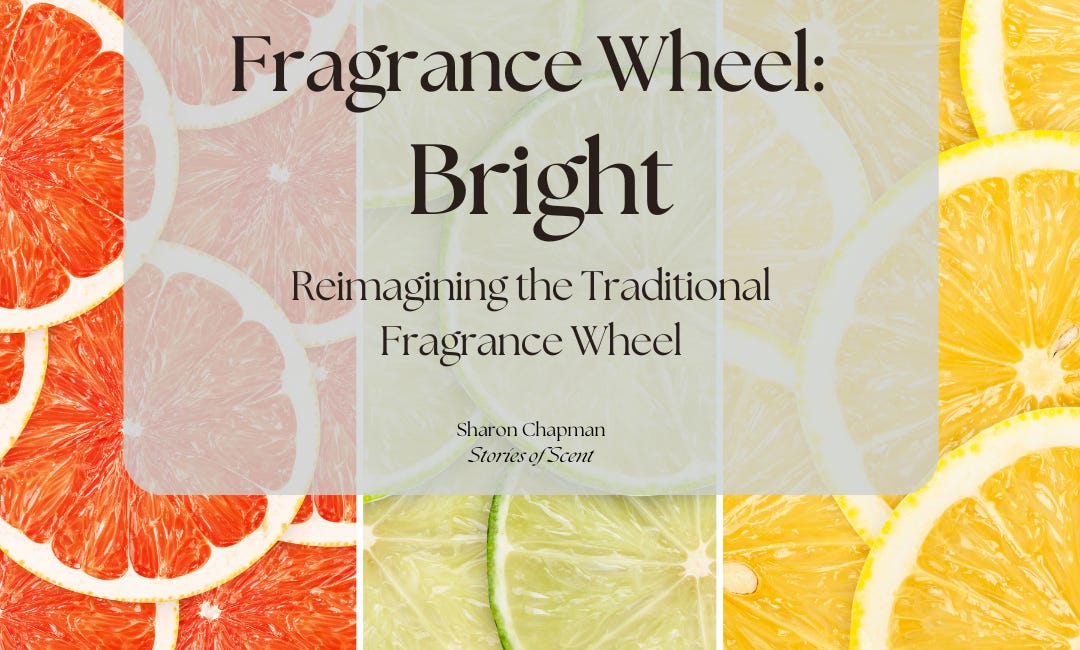Last week, we added the first part of the “second wheel” of my reimagined botanical scents fragrance wheel:
Building on the Botanical Scents Fragrance Wheel: Bright
Last week, I introduced you to the first part of my Botanical Scents Fragrance Wheel:
The aim of this project is to reimagine the traditional fragrance wheel used by perfumers and make one that is suited specifically to botanical scents - used by botanical perfumers and aromatherapists.
Over the years that I have been studying botanical perfumery, I have come up with some of my own interpretations/understandings based on the traditional fragrance families/wheel, which - to me - fit more easily with botanical perfumery.
As I started to think about this project, I realized that my Botanical Scents Fragrance Wheel was going to divert from the traditional fragrance wheel by one major component. It would have a “central” wheel: Floral. The reason I came up with this was personal. The majority of my fragrances have a floral element.
Building on this central floral wheel, I added the first of five different categories - based on the traditional fragrance wheel but renamed to reflect both botanical and personal reasons. The first spoke of this wheel was BRIGHT. This week, we are looking at VINTAGE.
What is Vintage in Perfumery?
My interpretation of vintage in botanical perfumery for this project is an extract (essential oil, CO2, absolute or other type of botanical extract) which is reminiscent of “old, ” often familiar, scents such as leather, tobacco, old books, and traditional raw honey. They are the elements that hark back to scents that are not easily obtained through one extract alone but could be a combination of scents (an accord) to gain the required element. I added honey into this category (which could also be grouped with my interpretation of gourmand scents coming up in a future article) because I am thinking of honey straight from the old beehives which is “vintage” and not as sweet as processed honey. Some straight extract examples int this category include:
tobacco absolute (Nicotiana tabacum)
oakwood absolute (Quercus robur)
patchouli (Pogestemon cablin)
vanilla CO2 (Vanilla planifolia)
coffee (Coffea arabica)
You can tincture some of these extracts, too (for example, vanilla). Examples of my fragrances which have a vintage element include Brown-eyed Brooks.
So, we now have both the central floral “wheel” and, the bright spoke and the vintage spoke. This looks something like this:
By the end of the journey, we will have put together a botanical scents fragrance wheel that you can exclusively use with botanical perfumery. However, remember that this is simply my own interpretation and there is no one size fits all.
BONUS: I will also be including a separate bonus wheel for paid subscribers!
Learning botanical scents and organizing them into some sort of reference tool is extremely useful as a perfumer.
Perfume formulation can be a puzzle - but it doesn’t have to be! By subscribing to and reading my short FREE articles each week, you’ll get nugget-sized pieces of information to build your scent tools. Upgrade to paid to take that learning deeper, and get examples of actual oils, absolutes, and extracts to build into your botanical scents fragrance wheel (in the coming months).
Please drop a heart below if you like this article, forward it to a friend, or invite someone to subscribe (and perhaps get a free month’s paid subscription for doing so!).
What did you learn from this article? Drop me your thoughts in the comments below.
““One of the things that attracts me to vintage and antique things is they have stories, and even if I don't know the stories, I make them up.”
Mary Kay Andrews, American Writer







